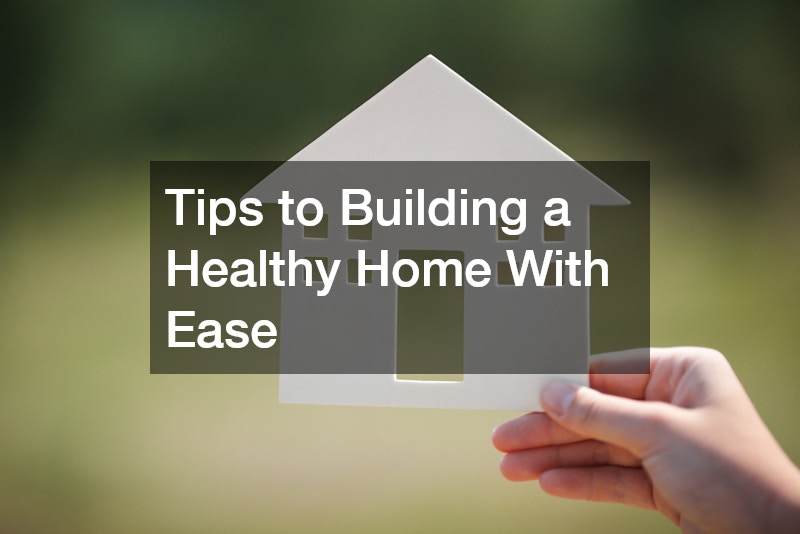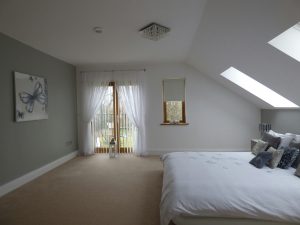Creating a home that not only serves as a shelter but also as a sanctuary for health and well-being is a pursuit many homeowners undertake. The concept of building a healthy home encompasses a variety of factors, ranging from the materials used in construction to the integration of technological advancements that enhance quality of life. Whether you are working with a luxury home builder to create a custom residence or looking to improve the functionality of an existing structure, prioritizing health and sustainability is vital. This comprehensive guide explores diverse strategies and considerations for optimizing your living space, making sure it supports both physical health and peace of mind. By understanding the importance of building a healthy home, you can invest intelligently in spaces that not only offer comfort and aesthetic appeal but also boost your overall wellness in the long term.
Choose High-End Craftsmanship for Long-Term Comfort and Value

Collaborating with a luxury home builder sets the foundation for creating a healthy home that aligns with personal values and lifestyle goals. High-end craftsmanship ensures that the materials and construction processes used contribute to a structurally sound and aesthetically pleasing environment. Investing in quality today equates to significant savings and increased comfort over time, as well-constructed homes experience fewer repair issues.
A focus on building a healthy home begins with the selection of safe, sustainable materials. From non-toxic paints to energy-efficient windows, every aspect of construction contributes to indoor air quality and overall home safety. Choosing superior materials and finishes creates a barrier against pollutants, supporting healthier indoor environments for all residents.
Additionally, high-end craftsmanship enhances a home’s efficiency and resilience, leading to lower energy costs and an extended lifespan. Working with an experienced luxury home builder ensures that your dwelling not only meets but exceeds health and sustainability standards. This proactive approach reinforces the notion of building a home, where long-term comfort and value are prioritized.
Address Structural Wear to Maintain Safety and Clarity Indoors
Regular home maintenance, including glass repair for home, is an integral aspect of building a healthy home. Damaged windows and glass can compromise both security and energy efficiency. Making sure that windows and doors are in top condition helps maintain indoor temperature balance and prevent external pollutants from entering the living space.
Beyond aesthetic concerns, addressing structural wear, such as leaking roofs or unstable support structures, is crucial for safety. A well-maintained home minimizes the risks of accidents or health issues related to mold and mildew, which often result from untreated leaks or poor ventilation. By staying vigilant about repairs, homeowners can foster a safer and healthier dwelling for all occupants.
For a sustainable and healthy home, consider investing in energy-efficient upgrades during repairs. Whether it’s upgrading to double-pane windows or increasing natural lighting, these improvements contribute to better structural integrity and healthier indoor environments. This aligns with the overarching objective of building a home, wherein safety and clarity are sustained.
Boost Energy Efficiency with Proper Sealing and Thermal Protection
Working with home insulation companies is an excellent strategy for enhancing a home’s energy efficiency. Proper insulation reduces the need for excessive heating or cooling, ultimately decreasing energy consumption and utility bills. By focusing efforts on effective sealing and thermal protection, you contribute to building a healthy home environment characterized by comfort all year round.
Energy efficiency also plays a significant role in minimizing a household’s ecological footprint. Sustainable insulation materials, such as recycled denim or cellulose, not only perform well environmentally but also provide superior thermal protection. These green insulation options contribute to better indoor air quality, thereby supporting the health aspects of building a home.
Moreover, thermal protection extends the life of HVAC systems, reducing repair costs and resource consumption. Advanced home insulation is a critical investment towards achieving a sustainable and healthy household, demonstrating how proactive measures significantly impact comfort, wellness, and financial savings.
Understand Property Worth Before Making Major Upgrades

Consulting home appraisal companies is an essential step before undertaking significant renovations or improvements. Understanding the current value of your property can help guide decisions, making sure upgrades align with financial goals. This approach ensures that investments made in building a home support its market value and enhance its attractiveness to potential buyers.
Major upgrades, such as renewable energy installations or smart home systems, can significantly affect property value. By assessing the financial and functional benefits through a professional appraisal, homeowners can prioritize projects that maximize both immediate comfort and long-term returns on investment. These considerations are fundamental in building a healthy home that stands the test of time.
A thorough appraisal also identifies areas where the home already excels and where improvements are needed, enabling targeted investments. This strategic insight helps homeowners allocate resources wisely, making sure that each upgrade contributes to a safer, healthier, and financially sound living environment.
Don’t Overlook the Needs of Specialized Housing Styles
Specialized housing styles, such as mobile homes, require unique maintenance and improvement strategies to maintain health and safety standards. Mobile home roof repairs, for example, are critical in preventing leaks and other issues that can degrade living conditions. Regular inspections and timely maintenance address these challenges, contributing to the goal of building a home.
Structural enhancements in mobile homes often revolve around stabilizing foundations and improving the efficiency of seasonal defenses. Properly insulated roofs and well-maintained HVAC systems are essential components of a healthy mobile home, aiding in reducing energy use and maintaining consistent indoor climates.
Investing in quality materials and skilled labor for mobile home maintenance ensures longevity and safety. These considerations play a crucial role in maintaining a healthy home, preventing issues that could otherwise compromise indoor air quality or overall well-being. Building a healthy home extends to all housing types, adapting strategies to suit each unique style.
Create Outdoor Shaded Areas That Support Relaxation and Health
Incorporating outdoor shaded areas is a beneficial aspect of building a home. A home awning company can provide solutions that create inviting outdoor spaces, suitable for relaxation and gatherings, while protecting against sun exposure. Shaded areas encourage residents to spend more time outdoors, contributing to improved mental and physical health.
Besides creating socially engaging spaces, awnings and other shade structures reduce household energy consumption by minimizing heat absorption. This can lead to savings on cooling costs, reinforcing the home’s overall energy efficiency. As such, investing in shaded outdoor areas also supports sustainability efforts aligned with building a home.
Moreover, customized awnings can enhance a property’s aesthetic appeal, potentially increasing its market value. This combination of beauty, functionality, and health benefits demonstrates how creating shaded spaces can be an integral part of an overarching strategy to build a healthy and balanced home environment.
Ensure Backup Power for Critical Household Systems

The inclusion of home generators in building plans ensures that essential household systems remain operational during power outages. Investing in reliable backup power sources is critical for maintaining the functionality of safety systems like security alarms and health-related appliances. It is also an aspect of building a home, as it maintains comfort and safety despite disruptions.
Generators facilitate the continuous operation of heating and cooling systems, which is critical during extreme weather conditions. By making sure these systems are reliable, homeowners protect indoor air quality and overall living conditions, supporting the endeavor of building a healthy home. These backup measures are vital for households reliant on electronic medical devices, underscoring the health-centric nature of power security.
Moreover, the availability of quality backup power enhances the resilience of the home, contributing to peace of mind. This investment demonstrates foresight and responsibility in home management, aligning with the broader goal of establishing a safe and sustainable living environment.
Secure Financial Support That Aligns With Long-Term Wellness Goals
Securing home mortgage loans is often a necessary step in financing the construction or renovation of a residence. When aligned with long-term wellness goals, these financial tools can support the development of a healthy home. It’s essential to choose loan options that accommodate future upgrades aimed at enhancing health and energy efficiency.
Homeowners are encouraged to explore financing options that allow flexibility in undertaking capital-intensive projects without compromising financial stability. This includes, but isn’t limited to, implementing energy-efficient systems or remodeling efforts that improve living conditions. Thoughtful planning ensures that loans contribute positively to building a healthy home instead of creating financial strain.
Furthermore, understanding the financial setting and available options empowers homeowners to make informed choices about investments in their homes. This financial literacy is fundamental, as it enables homeowners to align their economic resources with their vision of a healthy, comfortable dwelling. The right financial support is critical in realizing the dream of building a home.
Explore Minimalist Living as a Path to Simplicity and Efficiency
Minimalist living in tiny shipping container homes offers an innovative approach to sustainable habitation. These compact dwelling spaces prioritize efficiency and simplicity, embodying the principles of building a home. By reducing clutter and focusing on what is essential, residents experience improved mental clarity and reduced stress levels.
Tiny homes often incorporate sustainable materials and energy-efficient designs, reducing environmental impact. These features are aligned with the concept of building a healthy home, as they foster a living environment that promotes wellness and ecological consciousness. The streamlined designs also allow for maximum utilization of natural light and air flow, benefiting overall health.
Moreover, the adoption of minimalist living in shipping container homes encourages a lifestyle appreciative of resourcefulness and creativity. Embracing minimalism not only addresses contemporary housing challenges but also supports a holistic approach to well-being. This aligns perfectly with the pursuit of building a healthy home that offers both comfort and sustainability.
Financially, minimalist container homes can offer significant savings compared to traditional housing, freeing up resources for healthier lifestyle choices such as better nutrition, fitness, and preventive healthcare. Their smaller footprint also means lower utility bills and maintenance demands, contributing to a less stressful and more manageable home life. By removing the excess and focusing on intentional living, these homes exemplify how thoughtful design and conscious living choices can directly support physical, emotional, and financial health.
Incorporate Greenery Indoors and Out for a Balanced Living Space

Adding greenery through indoor plants or garden center creations enhances the aesthetic and health attributes of a home. Plants contribute to building a healthy home by improving air quality, reducing stress, and increasing productivity. Strategic placement of indoor plants can create tranquil atmospheres conducive to relaxation and contemplation.
Outdoor gardens or landscaped areas provide additional benefits that support physical and mental well-being. A planned green space becomes a haven for exercise and outdoor activity, promoting healthful living and improved mood. Engaging with one’s garden encourages physical activity and reduces stress, contributing to the family’s overall wellness.
In addition, integrating nature into residential areas aligns with growing trends toward sustainable and eco-friendly development. Greenery is an actionable means of building a healthy home, offering both practical and emotional benefits that enhance quality of life. Whether through potted plants or backyard gardens, nature adds beauty and balance to a home environment.
Greenery also plays a key role in temperature regulation and noise reduction within the home. Indoor plants can help maintain humidity levels and keep indoor climates more comfortable, while dense outdoor landscaping can buffer noise pollution and provide natural shade, reducing reliance on artificial cooling. These benefits contribute to a more peaceful and energy-efficient living space, reinforcing the overall goal of creating a healthy and harmonious home environment.
Incorporating these diverse strategies enhances the process of building a healthy home, making sure that it supports both current and future needs. By prioritizing quality craftsmanship, efficient design, and thoughtful resource use, homeowners can create environments that foster wellness and sustainability. The integration of greenery, energy-efficient technologies, and structural integrity further solidifies the foundation for a robust and health-centric living space.
Beyond the structural and functional elements, financial planning and mindfulness in renovations lead to smarter investments that align with long-term wellness goals. As we manage evolving housing trends, it becomes essential to focus on commodifying comfort through multifaceted approaches. Each section of this guide contributes to a larger structure for establishing homes that balance safety, efficiency, and aesthetic presence while nurturing health.
Ultimately, the pursuit of building a healthy home is a holistic endeavor, one that enhances life quality on multiple levels. Through careful planning, informed decision-making, and versatile design adaptations, homeowners can assure their living spaces truly reflect and support their well-being aspirations. Embracing these principles guarantees a home that transcends mere shelter to become a sanctuary of health and comfort.


